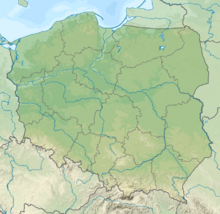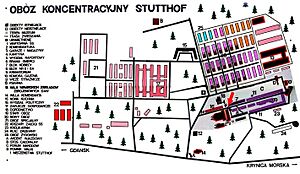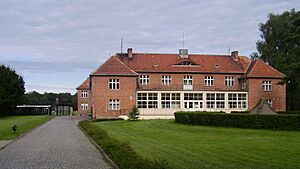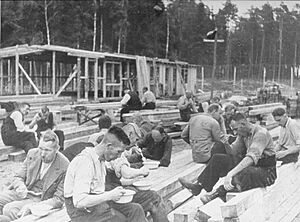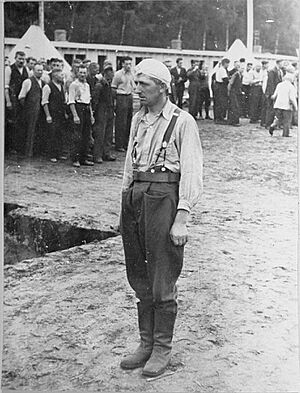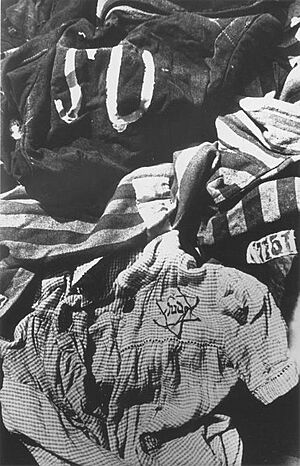Stutthof concentration camp facts for kids
Quick facts for kids Stutthof |
|
|---|---|
| Nazi concentration camp | |
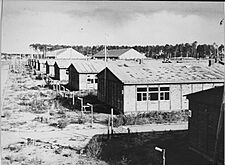
Prisoner barracks after liberation
|
|
| Coordinates | 54°19′44″N 19°09′14″E / 54.32889°N 19.15389°E |
| Location | Sztutowo |
| Operated by | Nazi Germany |
| Commandant | Max Pauly, September 1939 – August 1942 Paul-Werner Hoppe, August 1942 – January 1945 |
| Operational | 2 September 1939 – 9 May 1945 |
| Inmates | Poles, Jews, and political prisoners of various nationalities |
| Number of inmates | 110,000 |
| Killed | 63,000 - 65,000 (including 28,000 Jews) |
| Liberated by | Red Army |
Stutthof was a Nazi concentration camp built by Nazi Germany during World War II. It was located in a quiet, wooded area near the village of Stutthof (now called Sztutowo) in what was then German-controlled territory. The camp was about 34 kilometers (21 miles) east of the city of Danzig (now Gdańsk).
Stutthof was the first German concentration camp created outside of Germany during World War II. It opened on September 2, 1939, shortly after Germany invaded Poland. It was also the last camp to be freed by the Allies on May 9, 1945.
Historians believe that between 63,000 and 65,000 prisoners died at Stutthof and its smaller camps. These deaths were caused by murder, starvation, diseases, extremely hard work, forced evacuations, and a lack of medical care. About 28,000 of those who died were Jewish people.
In total, around 110,000 people were sent to Stutthof during its existence. Many were later moved to other locations. Today, the former camp is a memorial museum, opened in 1962, to remember the victims and teach about the past.
Contents
What Was Stutthof Camp?
The camp was first set up as part of a plan to remove Polish leaders and important people from the Danzig area. Even before the war, German groups made lists of people to arrest.
Stutthof began as a camp for civilians, managed by the Danzig police. Later, in November 1941, it became a "labor education" camp, where people were forced to work. By January 1942, it was officially a regular concentration camp.
The original camp was surrounded by barbed wire fences. It had eight barracks for prisoners and a building for the SS guards. In 1943, the camp grew much larger. A new section was built with thirty more barracks and an electrified barbed-wire fence.
A crematorium (a place to burn bodies) and a gas chamber were added in 1943. These were used for mass killings, especially after Stutthof became part of the "Final Solution" in June 1944. The "Final Solution" was the Nazi plan to murder all Jewish people.
Camp Staff and Guards
The camp was run by German SS guards. After 1943, Ukrainian helpers also worked as guards.
German women also served as SS guards, called Aufseherinnen, starting in 1942. Many of these female guards were later found to have committed terrible crimes against humanity.
Who Were the Prisoners?
The first 150 prisoners arrived on September 2, 1939. They were Poles and Jews arrested in Danzig. Within two weeks, the number of prisoners grew to 6,000. Until 1942, most prisoners were Polish.
In 1944, many more prisoners arrived, especially Jewish people. Thousands of Jewish prisoners were transferred to Stutthof from other camps like Auschwitz and camps in the Baltic states.
Prisoners at Stutthof came from 28 different countries. Besides Jews and Poles, there were Germans, Czechs, Dutch, French, Norwegians, Russians, and many others. Romani people were also imprisoned there.
Among the prisoners were members of the Polish underground resistance, Polish civilians from the Warsaw Uprising, and Soviet prisoners of war. Many people sent for immediate execution were never officially registered.
A Danish politician named Martin Nielsen was a notable survivor. He wrote a book about his experiences in the camp.
Life and Death in the Camp
Life in Stutthof was incredibly difficult. Tens of thousands of prisoners died from hunger and sickness. Many died during typhus epidemics in 1942 and 1944. Guards would gas prisoners who were too weak or sick to work.
The first executions by shooting happened in 1940. Gassing with a poison gas called Zyklon B began in June 1944. About 4,000 prisoners, including Jewish women and children, were killed in the gas chamber before the camp was evacuated. Other ways people were killed included lethal injections and being beaten to death.
Between 63,000 and 65,000 people died in Stutthof.
Many prisoners were forced to work for German companies. They worked in SS-owned factories, like the armaments factory located inside the camp. Others worked in brickyards, farms, or camp workshops. In 1944, a Focke-Wulf aircraft factory was built at Stutthof, using prisoners for labor. The Stutthof camp system eventually included about 105 smaller forced-labor camps across northern and central Poland.
The "Human Soap" Controversy
There was a long-standing belief that bodies from Stutthof were used to make soap at a lab in Danzig.
However, recent research by historians and scientists has shown that this was not true. While some human fat tissue was found in samples from the lab, it was a byproduct of a professor's work to create anatomical models from bodies, not from making soap. The lab was not part of the Stutthof camp. This rumor was mixed up with other false stories about human soap production during the war.
Smaller Camps (Sub-camps)
The main Stutthof camp had about 40 smaller camps, called sub-camps, during World War II. These sub-camps held 110,000 prisoners from 25 countries.
Some of the sub-camps included:
- Bottschin in Bocień
- Bromberg-Ost in Bydgoszcz
- Danzig–Holm (Gdańsk–Ostrów Island)
- Danzig–Neufahrwasser (Gdańsk–Nowy Port)
- Danziger Werft in Gdańsk
- Außenstelle Elbing in Elbląg
- Gotenhafen in Gdynia
- Außenarbeitslager Gerdauen (Zheleznodorozhny)
- Graudenz in Grudziądz
- KL Heiligenbeil (Mamonovo)
- Königsberg in Kaliningrad
- Lauenburg (Lębork)
- Potulitz in Potulice
- Praust/Pruszcz Gdański
- Schichau-Werft in Gdańsk
- Stolp/Słupsk
- Thorn (Toruń)
- Westerplatte in Gdańsk
Camp Leaders
Stutthof had two main commanders during its operation:
- Max Pauly: From September 1939 to August 1942
- Paul-Werner Hoppe: From August 1942 to January 1945
The Death March
The evacuation of prisoners from Stutthof began on January 25, 1945. There were almost 50,000 prisoners, mostly Jewish, in the camp system at that time. The German guards forced them to march towards Lauenburg in eastern Germany.
As Soviet forces advanced, the Germans made the surviving prisoners march back towards Stutthof. In late April 1945, the remaining prisoners were taken from Stutthof by sea because Soviet forces had surrounded the camp. Hundreds of prisoners were forced into the sea and shot. Over 4,000 were sent by small boats to Germany.
On May 5, 1945, a boat filled with starving prisoners arrived in Denmark, where 351 out of 370 on board were saved. Some prisoners were also taken to Sweden and released into that neutral country's care. It is thought that about half of the evacuated prisoners, over 25,000 people, died during these forced evacuations.
Soviet forces finally freed Stutthof on May 9, 1945. They rescued about 100 prisoners who had managed to hide.
Trials After the War
After World War II, several trials were held against the staff of concentration camps. Poland held four trials in Gdańsk for former guards and prisoner-guards from Stutthof. They were accused of war crimes and crimes against humanity.
The first trial was in 1946. Thirty former officials and guards were found guilty. Eleven, including the former commander, Johann Pauls, were sentenced to death. Others received prison sentences.
More trials followed in 1947, where many more guards were found guilty and some were sentenced to death.
In recent years, more trials have taken place. In 2020, Bruno Dey, a former camp guard who was about 17 at the time, received a suspended sentence for his role in the killings of over 5,230 prisoners.
In 2022, Irmgard Furchner, a 97-year-old former secretary at Stutthof, was found guilty of being involved in the murder of more than 10,000 people. She received a two-year suspended sentence. Her conviction was confirmed in August 2024. Survivors like Josef Salomonovic and Asia Shindelman bravely shared their experiences during her trial.
Notable People Connected to Stutthof
Survivors
- Reidar Kvammen, a Norwegian football player.
- Helen Lewis, a Czech dancer and choreographer.
- Martin Nielsen (politician), a Danish politician.
- Ingrid Pitt, a Polish-British actress and writer.
Those Who Died
- Eva Mamlok, a German anti-fascist and Jewish resistance fighter.
- Julia Rodzińska, a Catholic nun.
- Balys Sruoga, a Lithuanian poet and writer.
- Thøger Thøgersen, a Danish politician.
See also
- Female guards in Nazi concentration camps
- List of Nazi concentration camps
- Nazi crimes against ethnic Poles
- Rescue of Stutthof victims in Denmark


